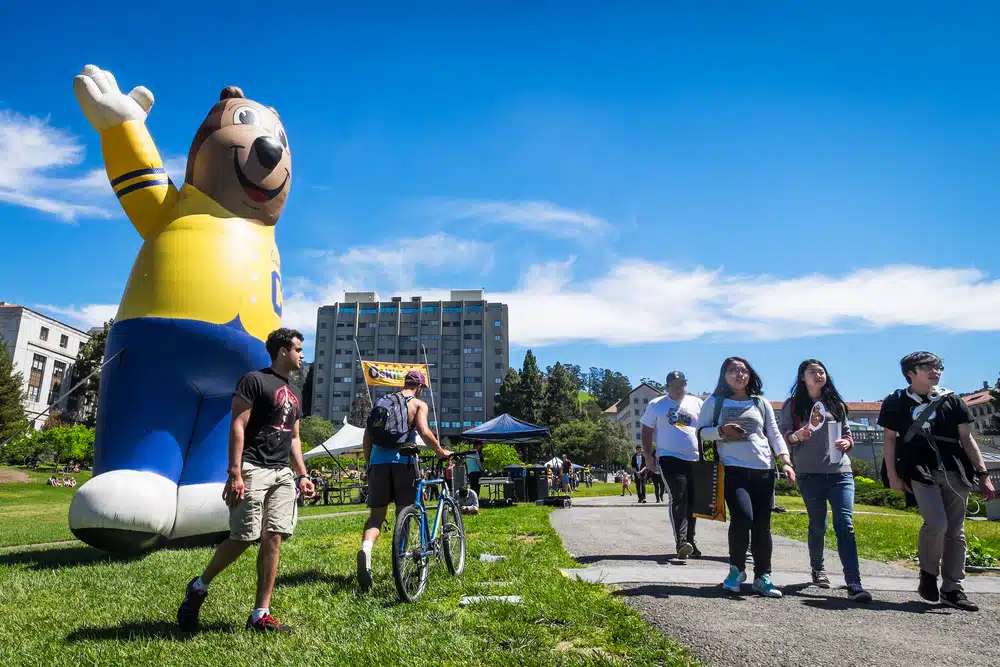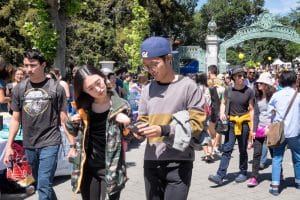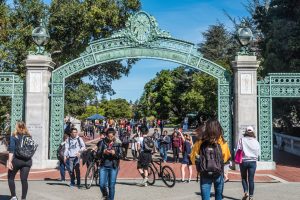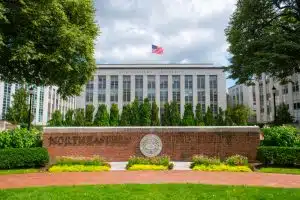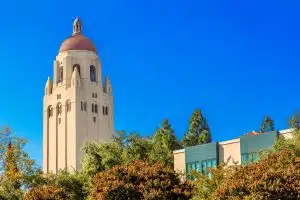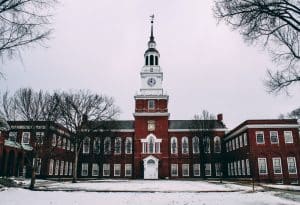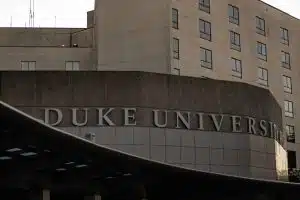Berkeley’s Official Mascot
Oski the Bear has been the official mascot of the University of California ever since he made his debut during the 1941 football season. This has been a long-standing tradition at the university. A number of other live mascots had been utilized at Memorial Stadium prior to his arrival, with variable degrees of success.

- Hometown: Berkeley, CA
- Year: Seventy-Eighth Year (Eternal Sophomore)
- Major: Double Major in Undecided and Undeclared
Historical Background
In the vibrant history of the University of California, Berkeley, the emergence of Oski the Bear as Berkeley’s official mascot marked a defining moment. The year was 1941, and the university’s spirit and sports culture were in need of a symbol that could encapsulate the energy and pride of the Golden Bears.
Prior to Oski’s creation, live bears were used at games, but the need for a more practical and enduring symbol led to the birth of Oski. Named after the “Oski Wow-Wow!” yell, a traditional cheer at Berkeley, Oski was introduced during a football game against St. Mary’s College, and his unique charm and charisma quickly won the hearts of students and faculty alike.
Since then, Oski’s presence has been a constant at Berkeley, representing not just the sports teams but the entire university community. As Berkeley’s official mascot, Oski’s creation marked a turning point in the university’s history, providing a unifying symbol that continues to resonate with generations of Golden Bears.
Symbolism
Oski the Bear is more than just a mascot; he’s a symbol of the spirit, tradition, and excellence that define the University of California, Berkeley. As Berkeley’s official mascot, Oski embodies the tenacity, innovation, and academic prowess that the university is renowned for.
His playful demeanor and engaging performances at games and events capture the essence of Berkeley’s vibrant student life, while his unwavering stance and determined expression reflect the university’s commitment to academic excellence and social activism.
Oski’s golden color is a tribute to the Golden State, and his name, derived from the spirited “Oski Wow-Wow!” cheer, encapsulates the joy and pride that students, alumni, and faculty feel for their alma mater.
In the grand tapestry of Berkeley’s history and culture, Oski stands as a timeless symbol, connecting past, present, and future generations of Golden Bears. His presence is a reminder of the unity, ambition, and excellence that make Berkeley one of the premier institutions of higher learning in the world.
What Makes Oski Unique?
Among the myriad of college mascots across the nation, Oski the Bear stands out as a truly unique figure. As Berkeley’s official mascot, Oski represents more than just the athletic prowess of the Golden Bears; he embodies the spirit, culture, and values of the University of California, Berkeley.
Design and Appearance
Oski’s design and appearance are as distinctive as his character. With his round face, open smile, and twinkling eyes, Oski exudes a warmth and friendliness that are instantly recognizable. Dressed in a cable-knit cardigan, adorned with a large letter “C,” and wearing a straw hat tilted jauntily to one side, Oski’s attire reflects a timeless and classic style.
His golden fur, a nod to California’s nickname as the Golden State, adds to his visual appeal. As Berkeley’s official mascot, Oski’s unique look sets him apart from other mascots, making him a beloved figure not just at games but across the entire Berkeley community.
Personality Traits
Oski’s character is as distinctive as his appearance, setting him apart from other college mascots. His playful and mischievous personality resonates with fans of all ages, making him a beloved figure at games and events.
Unlike many mascots who are designed to be fierce or intimidating, Oski’s approachable and friendly demeanor makes him accessible to everyone. As Berkeley’s official mascot, his antics, and interactions with fans are not just entertaining; they foster a sense of community and connection that transcends the game itself.
Whether he’s dancing with cheerleaders, and high-fiving fans, or engaging in playful banter with opposing teams, Oski’s character embodies the joy, spirit, and camaraderie that define the University of California, Berkeley.
Performances and Traditions
Oski’s role in games and campus events is integral to the traditions and culture of the University of California, Berkeley. As Berkeley’s official mascot, Oski’s performances are eagerly anticipated, whether he’s leading cheers at a football game, participating in rallies, or making surprise appearances at campus events.
His presence is a unifying force, bringing together students, alumni, and fans in a shared celebration of Golden Bear pride. Oski’s role extends beyond mere entertainment; he is a symbol of continuity and connection, linking generations of Berkeley enthusiasts.
His participation in time-honored traditions, such as the Big Game against Stanford and the annual Homecoming festivities, ensures that Oski’s spirit continues to thrive, reflecting the enduring values and community that make Berkeley a place like no other.
How Has Oski Evolved Over the Years?
Oski the Bear’s journey as Berkeley’s official mascot has been marked by evolution and growth. Since his introduction in 1941, Oski has undergone transformations in appearance, role, and impact on university culture.
These changes reflect not only the evolving identity of the University of California, Berkeley but also the broader shifts in societal values and expectations. Oski’s ability to adapt and remain relevant has ensured his enduring popularity and significance.
Changes in Appearance
Oski’s appearance has undergone subtle yet meaningful changes over the years. From his early days as Berkeley’s official mascot, Oski’s design has been tweaked to reflect the changing times and the evolving identity of the university.
His original look, characterized by a more rugged and bear-like appearance, gradually gave way to a softer and more approachable design. Changes in his attire, such as updates to his iconic cardigan and hat, have kept Oski’s look fresh and contemporary.
These visual transformations have not altered Oski’s core identity but have enhanced his appeal, ensuring that he continues to resonate with new generations of Golden Bears.
Evolution of Role
Oski’s role as Berkeley’s official mascot has expanded and diversified over the years. Initially introduced as a symbol for the university’s athletic teams, Oski’s presence has grown to encompass various aspects of campus life.
From participating in community outreach programs to being a central figure in university celebrations and traditions, Oski’s role has evolved to reflect the multifaceted spirit of Berkeley. His ability to connect with students, faculty, and alumni across different contexts has made Oski a unifying and beloved figure.
Whether he’s cheering on the Golden Bears at a game or spreading joy at a campus event, Oski’s presence enhances the sense of community and pride that defines Berkeley.
Impact on University Culture
Oski’s influence extends beyond games and events; he has a profound impact on the cultural fabric of the University of California, Berkeley. As Berkeley’s official mascot, Oski embodies the values, traditions, and aspirations of the university.
His presence fosters a sense of belonging and continuity, linking past, present, and future generations of Golden Bears. For students, Oski represents the joy, creativity, and resilience that characterize the Berkeley experience.
For alumni, he is a nostalgic symbol of their time at the university. Oski’s influence on student and alumni identity is a reflection of his ability to capture the essence of Berkeley, making him not just a mascot but a living symbol of what it means to be a part of this extraordinary community.
Witness Oski in Action
Experiencing Oski’s spirit on the University of California, Berkeley campus is an unforgettable part of being a Golden Bear. Oski’s presence is felt in various ways, from the roar of the crowd at games to the cherished traditions and even the merchandise that bears his likeness.
Attending Games
One of the most thrilling ways to experience Oski’s spirit is by attending games where he’s in action. As Berkeley’s official mascot, Oski is a central figure at football, basketball, and other sporting events, where his energetic performances and playful antics ignite the crowd.
Whether he’s leading cheers, dancing with the band, or engaging with fans, Oski’s presence adds a unique flair to the game-day experience. Seeing Oski in action is not just about entertainment; it’s about feeling a part of a community that celebrates excellence, sportsmanship, and the joy of being a Golden Bear.
Campus Traditions Involving Oski
Oski’s spirit is deeply embedded in the traditions and rituals of the University of California, Berkeley. From the annual Homecoming Parade to the Big Game Rally, Oski’s participation in these events is a cherished part of Berkeley’s cultural heritage.
As Berkeley’s official mascot, Oski’s role in these traditions goes beyond mere appearance; he embodies the values, history, and camaraderie that define the Berkeley experience.
Participating in or witnessing these traditions with Oski is a way to connect with the essence of Berkeley, creating memories and bonds that last a lifetime.
Merchandise and Memorabilia
Oski’s spirit extends beyond the campus through a wide range of merchandise and memorabilia that allow you to take a piece of Oski home with you. From plush toys and apparel to accessories adorned with Oski’s likeness, these items are a tangible connection to Berkeley’s official mascot and the university itself.
Owning a piece of Oski memorabilia is not just about having a souvenir; it’s a way to carry the spirit, pride, and memories of Berkeley with you, wherever you go. Whether you’re a student looking to show your Golden Bear pride or an alumni cherishing your time at Berkeley, Oski’s merchandise offers a way to keep the spirit of Oski alive and close to your heart.
The cultural impact of mascots
The role of mascots in higher education extends beyond entertainment and branding; they play a vital cultural role in shaping the identity and experience of a university. As Berkeley’s official mascot, Oski’s impact offers a glimpse into the profound influence mascots can have.
They become living symbols of the institution’s values, history, and aspirations, fostering a sense of belonging and continuity. Mascots like Oski create shared experiences and memories, bridging gaps between generations and diverse backgrounds.
They are not merely characters; they are storytellers, ambassadors, and connectors, enriching the educational journey with joy, pride, and a sense of community.
Final Thoughts
Oski the Bear, Berkeley’s official mascot, is more than just a figure cheering on the sidelines; he is the embodiment of the spirit, values, and traditions that define the University of California, Berkeley.
His ability to resonate with students, alumni, and visitors alike ensures that Oski’s spirit continues to thrive, reflecting the dynamic and inclusive nature of Berkeley. As a symbol, a friend, and a unifying force, Oski stands as a timeless testament to what it means to be a Golden Bear.
Whether you are a student embarking on your academic journey, an alumni cherishing memories, or a visitor exploring the campus, you are invited to engage with Oski’s spirit. As Berkeley’s official mascot, Oski’s presence offers a unique and enriching way to connect with the essence of the University of California, Berkeley.
Attend a game, participate in a tradition, or simply wear a piece of Oski merchandise, and you’ll feel the warmth, joy, and pride that Oski embodies. Engaging with Oski’s spirit is not just about celebrating a mascot; it’s about embracing the values, community, and excellence that make Berkeley an extraordinary place.
Come, be a part of the Golden Bear family, and let Oski’s spirit inspire and connect you to the heart of Berkeley.
Experience Berkeley school spirit with AdmissionSight
Seek the advice of experts in the field of college admissions, like those at AdmissionSight, to improve your chances of being accepted to Berkeley if that is one of your desired schools.
After more than a decade of helping students just like you get into their top- and second-choice schools, AdmissionSight has earned its reputation as the go-to resource for professional guidance on the college admissions process.
If you are interested in arranging a no-cost initial consultation, please get in touch with us as soon as possible.



